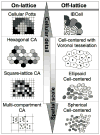Hybrid models of tumor growth
- PMID: 21064037
- PMCID: PMC3057876
- DOI: 10.1002/wsbm.102
Hybrid models of tumor growth
Abstract
Cancer is a complex, multiscale process in which genetic mutations occurring at a subcellular level manifest themselves as functional changes at the cellular and tissue scale. The multiscale nature of cancer requires mathematical modeling approaches that can handle multiple intracellular and extracellular factors acting on different time and space scales. Hybrid models provide a way to integrate both discrete and continuous variables that are used to represent individual cells and concentration or density fields, respectively. Each discrete cell can also be equipped with submodels that drive cell behavior in response to microenvironmental cues. Moreover, the individual cells can interact with one another to form and act as an integrated tissue. Hybrid models form part of a larger class of individual-based models that can naturally connect with tumor cell biology and allow for the integration of multiple interacting variables both intrinsically and extrinsically and are therefore perfectly suited to a systems biology approach to tumor growth.
Figures



References
Multicompartment CA
-
- Piotrowska MJ, Angus SD. A quantitative cellular automaton model of in vitro multicellular spheroid tumour growth. Journal of Theoretical Biology. 2009;258:165–178. - PubMed
-
- Basanta D, Hatzikirou H, Deutsch A. Studying the emergence of invasiveness in tumours using the game theory. Eur Phys J B. 2008;63:393–397.
Square-Lattice CA
-
- Dormann S, Deutsch A. Modeling of Self-Organized Avascular Tumor Growth with a Hybrid Cellular Automaton. In Silico Biology. 2002;2:393–406. - PubMed
-
- Stephanou A, McDougall SR, Anderson ARA, Chaplain MAJ. Mathematical Modelling of flow in 2D and 3D vascular networks: applications to anti-cancer and chemotherapeutic drug strategies. Math Comp Model. 2005;41:1137–1156.
-
- Owen MR, Alarcon T, Maini PK, Byrne HM. Angiognesis and vascular remodelling in normal and cancerous tissues. J Math Biol. 2009;58:689–721. - PubMed
Hexagonal-Lattice CA
-
- Deutsch A. Lattice-gas cellular autimata modeling of developing cell systems. In: Anderson A, Chaplain M, Rejniak KA, editors. Single-Cell-Based Models in Biology and Medicine. Chapter I.2 Birkhauser-Verlag; Basel, Switzerland: 2007.
-
- Shumate SD, El-Shenawee M. Computational model of ductal carcinoma in-situ: the effects of contact inhibition on pattern formation. IEEE Transactions on biomedical engineering. 2009;5:1341–1347. - PubMed
-
- Aubert M, Badoual M, Grammaticos B. A Model for Short- and Long-range Interactions of Migrating Tumour Cell Acta Biotheor. 2008b;56:297–314. - PubMed
Cellular Potts models
-
- Turner S, Sherratt JA, Cameron D. Tamoxifen treatment failure in cancer and the nonlinear dynamics of TGF-beta. Journal of Theoretical Biology. 2004;229:101–111. - PubMed
-
- Maree AFM, Grieneisen VA, Hogweg P. The cellular Potts model and biophysical properties of cells, tissues and morphogenesis. In: Anderson ARA, Chaplain MAJ, Rejniak KAR, editors. Single Cell Based Models in Biology and Medicine. Birkhauser; 2007.
Particle center based models (spherical)
-
- Drasdo D, Hoehme S. A single-cell-based model of tumor growth in vitro: monolayers and spheroids Phys. Biol. 2005;2:133–147. - PubMed
-
- Drasdo D, Hoehme S, Block M. On the role of physics in the growth and pattern formation of multi-cellular systems: what can we learn from individual – cell based models? J Stat Physics. 2007;128:287–345.
-
- Galle J, Hoffmann M, Aust G. From single cells to tissue architecture – a bottom-up approach to modelling the spatio-temporal organisation of complex multi-celluar systems. J Math Biol. 2009;58:261–283. - PubMed
Particle center based models (ellipsoidal)
-
- Kim Y, Stolarska MA, Othmer HG. A hybrid model for tumor spheroid growth in vitro, I: theoretical development and early results. Mathematical Models and Methods in Applied Sciences. 2007;17:1773–1798.
Particle center based models with Voronoi tessellation
-
- Schaller G, Meyer-Hermann M. Multicellular tumor spheroid in an off-lattice Voronoi-Delaunay cell model. Physical Review. 2005;71:051910. - PubMed
-
- Beyer T, Meyer-Hermann M. Multiscale modeling of cell mechanics and tissue organization. IEEE Eng Med Biol. 2009:38–45. - PubMed
-
- van Leeuwen IMM, Mirams GR, Walter A, Fletcher A, Murray P, Osborne J, Varma S, Young SJ, Cooper J, Doyle B, Pitt-Francis J, Momtahan L, Pathmanathan P, Whiteley JP, Chapman SJ, Gavaghan DJ, Jensen OE, King JR, Maini PK, Waters SL, Byrne HM. An integrative computational model for intestinal tissue renewal. Cell Prolif. 2009;42(5):617–636. - PMC - PubMed
Deformable cells
-
- Rejniak KA. An immersed boundary framework for modelling the growth of individual cells: an application to the early tumour development. J Theor Biol. 2007;247:186–204. - PubMed
-
- Dillon RH, Owen M, Painter K. A single-cell-based model of multicellular growth using the immersed boundary method. AMS Contemporary Mathematics. 2008;466:1–15.
-
- Rejniak KA, Dillon RH. A single cell based model of the ductal tumour microarchitecture. Computational and Mathematical Methods in Medicine. 2007;8:51–69.
Other
-
- Szeto MD, Chakraborty G, Hadley J, Rockne R, Muzi M, Alvord EC, Krohn KA, Spence AM, Swanson KR. Quantitative Metrics of Net Proliferation and Invasion Link Biological Aggressiveness Assessed by MRI with Hypoxia Assessed by FMISO-PET in Newly Diagnosed Glioblastomas. Cancer Res 2009. 2009;69:4502–4509. - PMC - PubMed
Further Reading
Reviews: cancer growth
-
- Preziosi L, editor. Cancer modeling and simulation. Champan & Hall; 2003.
-
- Araujo RP, McElwain DLS. A History of the study of solid tumour growth: the contribution of mathematical modeling. Bulletin of Mathematical Biology. 2004;66:1039–1091. - PubMed
-
- Byrne HM, Alarcon T, Owen MR, Webb SD, Maini PK. Modelling aspects of cancer dynamics: a review. Phil Trans R Soc A. 2006;364:1563–1578. - PubMed
-
- Anderson ARA, Chaplain MAJ, Rejniak KA, editors. Single-cell-based models in biology and medicine. Birkhauser-Verlag; 2007.
Reviews: integration of biological and mathematical modeling
Publication types
MeSH terms
Grants and funding
LinkOut - more resources
Full Text Sources

